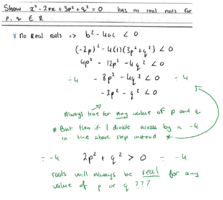Hello all,
See attached photo for my problem. I would be very grateful for any help.

My understanding is that I can divide across by the negative 4 in step 4 above out of convention to make things a little easier to work with but I can't get my head around why this is affecting my answer.
Am I missing some sort of fundamental transformation that's occurring to the quadratic?
See attached photo for my problem. I would be very grateful for any help.

My understanding is that I can divide across by the negative 4 in step 4 above out of convention to make things a little easier to work with but I can't get my head around why this is affecting my answer.
Am I missing some sort of fundamental transformation that's occurring to the quadratic?



